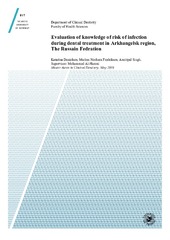| dc.contributor.advisor | Al-Haroni, Mohammed | |
| dc.contributor.author | Danielsen, Katarina | |
| dc.contributor.author | Singh, Amritpal | |
| dc.contributor.author | Norlunn Fredriksen, Markus | |
| dc.date.accessioned | 2020-01-13T09:21:41Z | |
| dc.date.available | 2020-01-13T09:21:41Z | |
| dc.date.issued | 2019-05-20 | |
| dc.description.abstract | Aim:
Considering the increase in HIV and other blood-borne diseases in the Russian Federation, the lack of national guidelines and standard precautions in dental health care settings, as well as the antibiotic resistance rising to dangerously high levels in all parts of the world, the aim of this study was to evaluate the infection control practice to assess the knowledge of risk of infection in dental health care settings (DHCS) among last year dental students and practicing dentists in dental clinics in Arkhangelsk region in the Russian Federation.
Materials and methods:
A questionnaire was distributed to practicing dentists and last year dental students in the Arkhangelsk region of the Russian Federation in the period of March to April 2018. It included 25 close-ended questions related to infection control routines in the dental clinics, relayed on the standards and recommendations published by the CDC. The questions were given scorable values of 1 point for correct answer and 0 points for incorrect answer, with 0 points indicating suboptimal knowledge of risk of infection and 1 point indicating good knowledge of risk of infection.
Results:
87 respondents participated in this study, which gave a response rate of 14.5%. The obtained results were analyzed using SPSS. The overall score was 72.5%, indicating intermediate knowledge of risk of infection. The domain with the poorest result was protective wear (53.8%), while the domain with the best result was vaccination and management of sharp instruments (85.4%).
Discussion:
In this study, the participants showed an overall intermediate knowledge of risk of infection during dental treatments. The results from this study highlight the need for national guidelines in DHCS, and emphasizes the need of further instruction and implementation of infection control during the course of study, as well as continuous refreshing and coursing on the subject throughout the practice of dental health care personnel (DHCP). | en_US |
| dc.identifier.uri | https://hdl.handle.net/10037/17077 | |
| dc.language.iso | eng | en_US |
| dc.publisher | UiT Norges arktiske universitet | en_US |
| dc.publisher | UiT The Arctic University of Norway | en_US |
| dc.rights.accessRights | openAccess | en_US |
| dc.rights.holder | Copyright 2019 The Author(s) | |
| dc.rights.uri | https://creativecommons.org/licenses/by-nc-sa/4.0 | en_US |
| dc.rights | Attribution-NonCommercial-ShareAlike 4.0 International (CC BY-NC-SA 4.0) | en_US |
| dc.subject.courseID | ODO-3901 | |
| dc.subject | VDP::Medisinske Fag: 700::Klinisk odontologiske fag: 830::Andre kliniske odontologiske fag: 849 | en_US |
| dc.subject | VDP::Medical disciplines: 700::Clinical dentistry disciplines: 830::Other clinical dentistry disciplines: 849 | en_US |
| dc.title | Evaluation of knowledge of risk of infection during dental treatment in Arkhangelsk region, The Russain Fedration. | en_US |
| dc.type | Master thesis | en_US |
| dc.type | Mastergradsoppgave | en_US |


 English
English norsk
norsk
